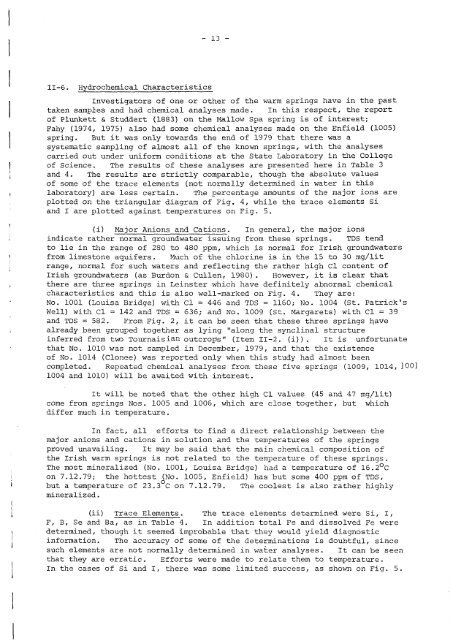Hydrogeothermal Conditions in Ãire - Geological Survey of Ireland
Hydrogeothermal Conditions in Ãire - Geological Survey of Ireland
Hydrogeothermal Conditions in Ãire - Geological Survey of Ireland
You also want an ePaper? Increase the reach of your titles
YUMPU automatically turns print PDFs into web optimized ePapers that Google loves.
- 13 -11-6. Hydrochemical CharacteristicsInvestigators <strong>of</strong> one or other <strong>of</strong> the warm spr<strong>in</strong>gs have <strong>in</strong> the pasttaken samples and had chemical analyses made. In this respect, the report<strong>of</strong> Plunkett & Studdert (1883) on the Mallow Spa spr<strong>in</strong>g is <strong>of</strong> <strong>in</strong>terest;Fahy (1974, 1975) also had some chemical analyses made on the Enfield (1005)spr<strong>in</strong>g. But it was only towards the end <strong>of</strong> 1979 that there was asystematic sampl<strong>in</strong>g <strong>of</strong> almost all <strong>of</strong> the known spr<strong>in</strong>gs, with the analysescarried out under uniform conditions at the State Laboratory <strong>in</strong> the College<strong>of</strong> Science. The results <strong>of</strong> these analyses are presented here <strong>in</strong> Table 3and 4. The results are strictly comparable, though the absolute values<strong>of</strong> some <strong>of</strong> the trace elements (not normally determ<strong>in</strong>ed <strong>in</strong> water <strong>in</strong> thislaboratory) are less certa<strong>in</strong>. The percentage amounts <strong>of</strong> the major ions areplotted on the triangular diagram <strong>of</strong> Fig. 4, while the trace elements siand I are plotted aga<strong>in</strong>st temperatures on Fig. 5.(i) Major Anions and Cations. In general, the major ions<strong>in</strong>dicate rather normal groundwater issu<strong>in</strong>g from these spr<strong>in</strong>gs. TDS tendto lie <strong>in</strong> the range <strong>of</strong> 280 to 480 ppm, which is normal for Irish groundwatersfrom limestone aquifers. Much <strong>of</strong> the chlor<strong>in</strong>e is <strong>in</strong> the 15 to 30 mg/litrange, normal for such waters and reflect<strong>in</strong>g the rather high Cl content <strong>of</strong>Irish groundwaters (as Burdon & Cullen, 1980). However, it is clear thatthere are three spr<strong>in</strong>gs <strong>in</strong> Le<strong>in</strong>ster which have def<strong>in</strong>itely abnormal chemicalcharacteristics and this is also well-marked on Fig. 4.They are:NO. 1001 (Louisa Bridge) with Cl = 446 and TDS = 1160; No. 1004 (st. Patrick'sWell) with Cl = 142 and TDS = 636; and No. 1009 (St. Margarets) with Cl = 39and TDS = 582. From Fig. 2, it can be seen that these three spr<strong>in</strong>gs havealready been grouped together as ly<strong>in</strong>g "along the syncl<strong>in</strong>al structure<strong>in</strong>ferred from two Tournaisian outcrops" (Item 11-2. (i». It is unfortunatethat No. 1010 was not sampled <strong>in</strong> December, 1979, and that the existence<strong>of</strong> No. 1014 (Clonee) was reported only when this study had almost beencompleted. Repeated chemical analyses from these five spr<strong>in</strong>gs (1009, 1014, JOO]1004 and 1010) will be awaited with <strong>in</strong>terest.It will be noted that the other high Cl values (45 and 47 mg/lit)come from spr<strong>in</strong>gs Nos. 1005 and 1006, which are close together, but whichdiffer much <strong>in</strong> temperature.In fact, all efforts to f<strong>in</strong>d a direct relationship between themajor anions and cations <strong>in</strong> solution and the temperatures <strong>of</strong> the spr<strong>in</strong>gsproved unavail<strong>in</strong>g. It may be said that the ma<strong>in</strong> chemical composition <strong>of</strong>the Irish warm spr<strong>in</strong>gs is not related to the temperature <strong>of</strong> these spr<strong>in</strong>gs.The most m<strong>in</strong>eralized (No. 1001, Louisa Bridge) had a temperature <strong>of</strong> l6.2 o Con 7.12.79; the hottest (No. 1005, Enfield) has but some 400 ppm <strong>of</strong> TDS,but a temperature <strong>of</strong> 23.3 0 C on 7.12.79. The coolest is also rather highlym<strong>in</strong>eralized.(ii) Trace Elements. The trace elements determ<strong>in</strong>ed were Si, I,F, B, Se and Ba, as <strong>in</strong> Table 4. In addition total Fe and dissolved Fe weredeterm<strong>in</strong>ed, though it seemed improbable that they would yield diagnostic<strong>in</strong>formation. The accuracy <strong>of</strong> some <strong>of</strong> the determ<strong>in</strong>ations is doubtful, s<strong>in</strong>cesuch elements are not normally determ<strong>in</strong>ed <strong>in</strong> water analyses. It can be seenthat they are erratic. Efforts were made to relate them to temperature.In the cases <strong>of</strong> Si and I, there was some limited success, as shown on Fig. 5.
















